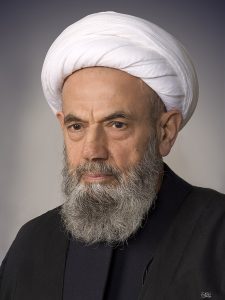Muḥammad Hādī Maʿrifat, Tārīkh-i Qurʾān (History of the Qurʾān), 5th ed., 1 vol., Tehran: Samt Publication, 1382, 216 pp.
Qurʾānic studies is a set of fields related to the Qurʾān, which includes a wide range of knowledge such as interpretation, tajwīd, recitation, the occasion of the revelation of Qurʾānic verses, rhetoric of the Qurʾān, history of the Qurʾān, and hermeneutics. In recent decades, the efforts of Shiʿa and Sunni scholars to better explain these issues have expanded and led to the authoring of numerous and valuable books on this topic. Tārīkh-i Qurʾān (History of the Qurʾān) in Persian by Ayatollah Muḥammad Hādī Maʿrifat is an effort in this regard.
 Born in 1309 (solar) in Karbala, Iraq, Ayatollah Muḥammad Hādī Maʿrifat is a prominent contemporary Shiʿa scholar who migrated to Iran in 1351 (solar). He was an expert in Qurʾānic studies and his works in this field (such as al-Tamhīd fī ʿUlūm al-Qurʾān, Ṣiyānat al-Qurʾān min al-Taḥrīf, and al-Tafsīr wa al-Mufassirūn) are among the reference books for researchers in this field. He passed away in 1385 (solar) and was buried in the holy shrine of Lady Maʿṣūma (a) in Qom, Iran.
Born in 1309 (solar) in Karbala, Iraq, Ayatollah Muḥammad Hādī Maʿrifat is a prominent contemporary Shiʿa scholar who migrated to Iran in 1351 (solar). He was an expert in Qurʾānic studies and his works in this field (such as al-Tamhīd fī ʿUlūm al-Qurʾān, Ṣiyānat al-Qurʾān min al-Taḥrīf, and al-Tafsīr wa al-Mufassirūn) are among the reference books for researchers in this field. He passed away in 1385 (solar) and was buried in the holy shrine of Lady Maʿṣūma (a) in Qom, Iran.
Tārīkh-i Qurʾān consists of an introduction and 6 chapters. The historical course of the books written about the history of the Qurʾān and the Qurʾānic studies is one of the important topics in the introduction of the book. In the first chapter, introductory topics such as revelation (waḥy), recognition of revelation, and the possibility of revelation are discussed. Also, the reasons given for the impossibility of the revelation are criticized and the question is answered, how does a person find this qualification to be the recipient of God’s direct message and is it possible for this message to be changed during or after communication? In this chapter, Ayatollah Muḥammad Hādī Maʿrifat also explains about the history of the beginning of revelation in general and Qurʾānic revelation in particular, how the revelation was revealed to the Prophet (s) and how it was narrated to the writers of the revelation and how it was recorded, as well as the way of writing at that time, the story of Waraqat b. Nawfil and the legend of Gharānīq.
In the second chapter of Tārīkh-i Qurʾān, the beginning of the revelation of the Qurʾān and the three-year delay after the beginning of the revelation, the duration of the revelation of the Qurʾān and its all-at-once and gradual revelation, and the opinions of the scholars regarding the all-at-once revelation of the Qurʾān are discussed. The order of the revelation of the sūrahs (chapters), Meccan and Medinan sūrahs, the criteria for distinguishing Meccan sūrahs from Medinan ones, the benefits of knowing Meccan and Medinan sūrahs, the occasion of revelation and the difference between sabab al-nuzūl and shaʾn al-nuzūl, the names of the Qurʾān, the meaning of sūrah and āyah, the names of sūrahs and whether the names of sūrahs are decided by the Prophet (s), and the number of verses and sūrahs are among other topics discussed in this chapter.
In the third chapter, the order and compilation of the Qurʾān, and the order of the verses in each chapter and its determination by the Prophet are discussed. Referring to the Muṣḥafs of the Companions, the author deals with ʿUthmān’s action in collecting them and preparing a single Muṣḥaf, and the features of this Muṣḥaf, as well as topics such as the Muṣḥaf of Imam Ali (a), the origin of the Arabic script, the differences between the Muṣḥafs, and the evolution of the Qurʾānic calligraphy until the printing period.
 Different recitations (qirāʾas) of the Qurʾān is the subject of the fourth chapter of Tārīkh-i Qurʾān. Ayatollah Maʿrifat deals with the factors of difference in recitation and the way to recognize the correct recitation, and while introducing the Seven Reciters, the Ten Reciters, and the Fourteen Reciters, he answers the question whether all seven recitations are mutawātir and authentic or not. According to him, based on three reasons, the recitation of Ḥafṣ is the only recitation that has a valid chain and has been common among Muslims for many centuries.
Different recitations (qirāʾas) of the Qurʾān is the subject of the fourth chapter of Tārīkh-i Qurʾān. Ayatollah Maʿrifat deals with the factors of difference in recitation and the way to recognize the correct recitation, and while introducing the Seven Reciters, the Ten Reciters, and the Fourteen Reciters, he answers the question whether all seven recitations are mutawātir and authentic or not. According to him, based on three reasons, the recitation of Ḥafṣ is the only recitation that has a valid chain and has been common among Muslims for many centuries.
The fifth chapter is about the distortion (taḥrīf) of the Qurʾān, which has been rejected by the vast majority of Muslim scholars throughout history. After defining taḥrīf, the author gives 7 reasons to reject the distortion of the Qurʾān, including the frequency of the Qurʾān, divine guarantee, narrations, and the fact that the Qurʾān is a miracle. Then, the narrations in some Shiʿa and Sunni sources that have led some to believe in distortion of the Qurʾān are analyzed, and it is concluded that these narrations do not prove the distortion.
The final chapter of Tārīkh-i Qurʾān is about the translation of the Qurʾān. The importance of the translation of the Qurʾān and its different methods, the views and reasons of opponents of the translation of the Qurʾān and their answers, the history of the translation of the Qurʾān, and the conditions of translation and translator are among the topics of this chapter. In the final section, Ayatollah Muḥammad Hādī Maʿrifat points out that the Qurʾān has been translated into more than 65 languages and states clearly that some translators were among the enemies of Islam and translated the Qurʾān with bad intentions, and therefore the duty of Muslim scholars is to constantly monitor the translations provided for the Qurʾān.
